
Education
Taking grandparents to school: how school-community-family collaboration empowers intergenerational learning in China
H. Cheng
This fascinating study by Hao Cheng uncovers the dynamic roles of schools, families, and communities in fostering intergenerational learning through an innovative project in China that brings grandparents into the classroom. Discover how this collaboration not only enriches education but also bridges generational gaps.
~3 min • Beginner • English
Introduction
Population aging generates negative effects including fiscal burdens, labor market imbalances, strained educational resource supply, and complex intergenerational conflicts. Promoting positive and successful aging and intergenerational justice has become a key societal aim. Beyond health and social participation, education and learning for older adults—and specifically intergenerational learning—are emphasized for eliminating ageism and fostering harmonious intergenerational relationships. Despite its promise, intergenerational learning often faces practical barriers: mismatched schedules, inadequate resources and staffing, cognitive decline and digital anxiety among older adults, and informal/non-institutionalized structures that hinder sustainability. In China, where family culture is strong and grandparent–grandchild relationships are central, intergenerational learning has evolved from family-based to include community and school contexts. A primary school in eastern China, together with a community, launched the “taking grandparents to school” project, widely recognized by stakeholders. The core research question is how school–community–family collaboration creates and empowers such intergenerational learning in practice. The study seeks to construct a theoretical model, disseminate practical experience, and inform policy on collaborative education, intergenerational learning, and older adult education. Field research and action research approaches are used to reveal mechanisms of collaboration and to discuss a theoretical framework, implications, and limitations with future directions.
Literature Review
The literature notes persistent generation gaps in knowledge, skills, values, and emotions, manifesting as prejudice, discrimination, language conflicts, and emotional confrontation. Dialogue and democratic engagement are proposed to bridge these gaps, with intergenerational learning shown to mitigate conflict and promote integration, though prior work rarely explains how such practices are created. School–community–family collaboration has evolved from informal to institutionalized forms to advance students’ development, but critiques argue that collaboration often centers solely on children, overlooking parents, teachers, and other participants. Diverse intergenerational learning models exist globally: family-based models in Confucian-influenced Asian contexts; service-center models in European welfare states; and embedded models in U.S. educational settings. However, many models reflect separation among school, community, and family, limiting innovation. The study hypothesizes that embedding intergenerational learning within collaborative education ecosystems can revitalize practice. Age-friendly initiatives, notably Age-Friendly Universities, expand opportunities for older learners, yet university social service limits suggest the importance of activating primary schools and communities as age-friendly educational hubs. The theoretical framework draws on Epstein’s theory of overlapping spheres of influence, positing that families, schools, and communities contribute unique and overlapping educational forces. In China, policy increasingly endorses cooperative education across these spheres, providing a context for the current case.
Methodology
Design and approach: Qualitative case study and practical action research focused on a two-month summer intergenerational learning project (“taking grandparents to school”) created through collaboration among a primary school, a community center, and families in eastern China. Data collection used unstructured interviews.
Setting and case background: Guang Ming Primary School (pseudonym), an urban primary school in Changzhou, Jiangsu Province, established in 1913, and Guang Ming Community Center (pseudonym), a nearby public cultural service organization. The project involved students (age 9–10) from a third-grade class (28 students; 15 boys), with 12 families volunteering to participate, leveraging proximity and existing school–community ties. Activities were hosted at the community center for accessibility and resource availability.
Participants: Interviews included school staff (principal and teacher), two community educators, and family members (parents, grandparents, and grandchildren) from participating families. A demographic table lists 18 interviewees (principal, a second school leader, two community educators, five parents, five grandparents, and five grandchildren aged 9–10), reflecting the range of roles engaged in the project.
Procedures and analysis: The researcher collaborated with the school leadership since 2019 on intergenerational learning initiatives and observed the full process of initiating and creating this project. Interviews were categorized according to the school–community–family collaboration framework, then dynamically reviewed to reflect the socio-cultural context. Member checking was conducted by feeding back the article to participants; adjustments were made to confirm accuracy. Coding consistency was reported as high, aiming to reduce subjective bias and enhance reliability and validity.
Key Findings
- Distinct and irreplaceable roles: Schools, communities, and families each play unique roles in empowering intergenerational learning.
- School’s proactive design: Guided by educational policy and responsibility, the primary school initiated and designed the project, engaged parents and grandparents through home visits and meetings, and framed the initiative around positive aging, child development, and family harmony.
- Community as collaborative support: Community educators embraced the project as part of their service and age-friendly mandate, providing organizational capacity, scheduling, learning spaces, human resources, and on-site coordination to translate concept into practice.
- Family as subjective participants: Parents, grandparents, and grandchildren actively participated to address generation gaps and foster intergenerational integration. Parents sought professional support due to limited family education literacy; grandchildren and grandparents formalized participation (e.g., commitment letters) and attended planned sessions together.
- Practical parameters: The project ran over a two-month summer period, invited 12 families from a class of 28 students (ages 9–10), and leveraged the nearby community center for accessibility.
- Emergent intergenerational relationships: The project facilitated new mutual-learning relationships between grandparents and grandchildren and demonstrated an operative model of collaboration aligned with policy on cooperative education.
Discussion
The study addresses fragmentation in prior intergenerational learning models by demonstrating how an integrated school–community–family ecosystem can create and sustain practice. It extends the traditional focus of collaboration beyond child-only outcomes to include multiple subjects—grandparents, parents, and children—as co-learners and beneficiaries. Embedding intergenerational learning within local collaborative structures counters the separation seen in family-, community-, or school-only models, thereby activating the potential of cooperative education. In relation to age-friendly agendas, the findings suggest that primary schools and communities, not only universities, can serve as frontline age-friendly educational providers that meet older adults’ learning needs while supporting youth development. The collaborative roles—school program design, community resource provision, and family participation—together produce a viable pathway from concept to practice, offering insights for cross-boundary education, intergenerational relations, learning mechanisms, and social change.
Conclusion
Intergenerational learning can be effectively created through coordinated roles of schools (program design and guidance), communities (age-friendly services and resources), and families (active participation to bridge generation gaps). The case demonstrates a practical and theoretical framework—grounded in Chinese policy and cultural context—for transforming intergenerational learning from an idea into sustainable practice. The project highlights how collaborative education ecosystems foster mutual learning between grandparents and grandchildren and contribute to addressing population aging and intergenerational conflict. Implications include strengthening theory on cooperative education for intergenerational learning, guiding educators and policymakers in strategic collaboration, and encouraging broader dissemination and local adaptation of the model across diverse cultural and educational systems.
Limitations
Related Publications
Explore these studies to deepen your understanding of the subject.







